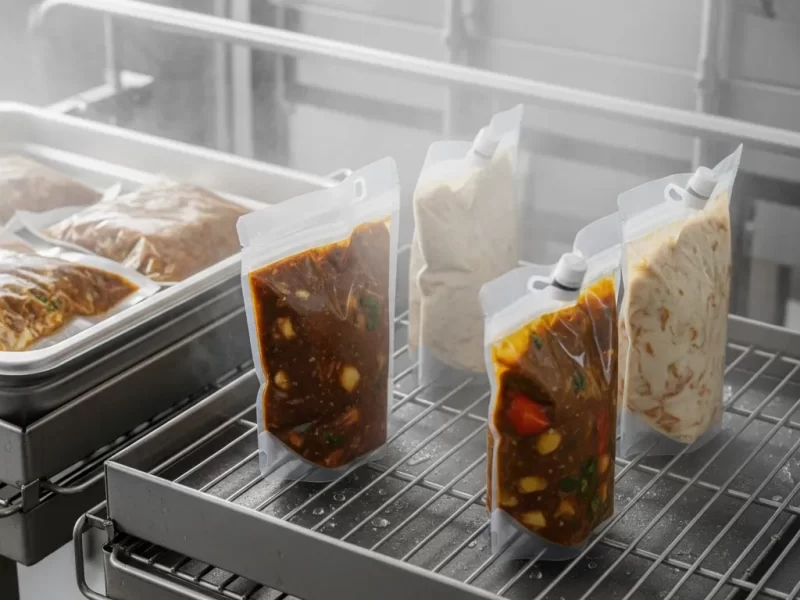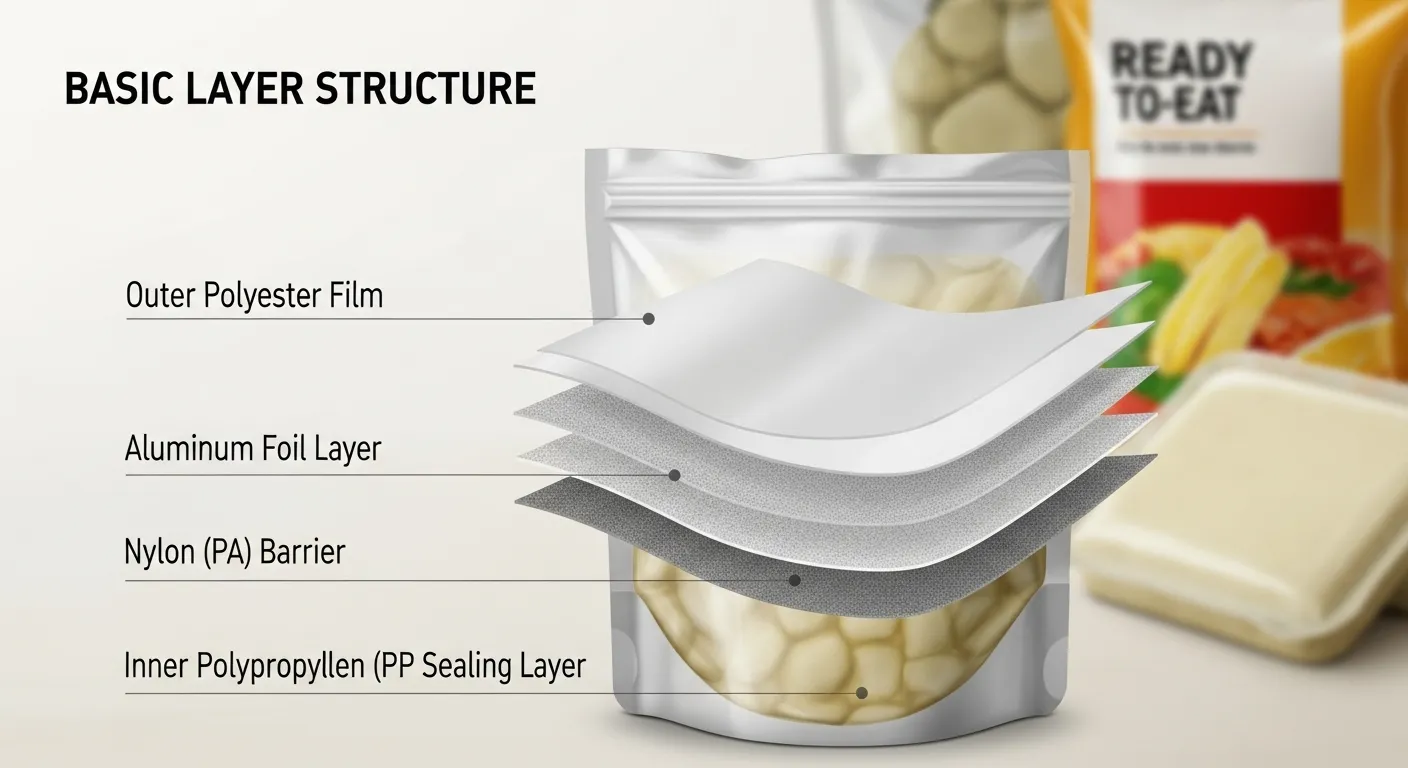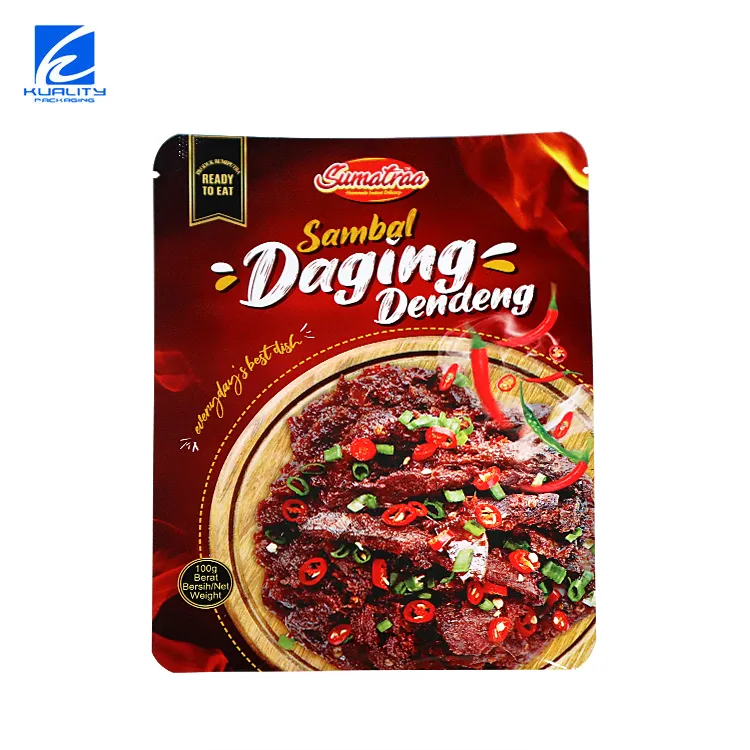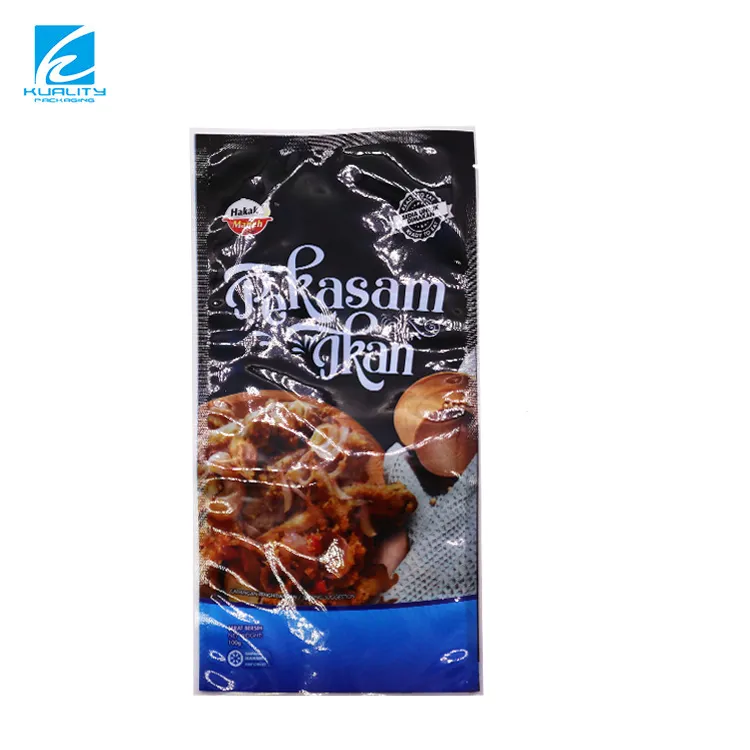
후이양 패키징에서, we’ve spent years on the front lines of OEM production for international pet food brands, handling tens of thousands of high-temperature retort bags daily. We’ve seen the real challenges: aluminum foil pouches bursting during 121℃ sterilization, and eco-friendly materials being rejected and redone. These are not textbook theories—they’re hard-earned lessons from the production floor. As a custom retort pouch manufacturer, we know that material selection is a critical balance between heat resistance, cost efficiency, and product safety. Our experience ensures you get reliable, production-ready packaging every time.
The “hell test” of High-Temperature Retort Bags: What materials Can Withstand 121℃?
Basic four-layer structure (industry standard)

When you open the packaging of a bag of instant curry, you will see this “stacked nail flow”:
Outer layer: 12μm PET film
- Function: scratch-resistant, puncture-resistant, and the logo will not fade.
- Secret: A brand once switched to BOPP to save money, but the printed pattern became an abstract painting after retorting, and it lost 800,000 yuan.
Secondary layer: 15μm nylon (PA)
- Function: impact resistance + oxygen penetration prevention, equivalent to the “ligament” of the packaging.
- Rollover case: A certain OEM factory mistakenly used unstretched PA, and the shrinkage rate exceeded 5% after cooking at 121℃, and the bag wrinkled into sauerkraut.
Core: 7μm aluminum foil
- Function: blocks oxygen, light, and water vapor, a life-saving core.
- Pain point: The pinhole rate of the aluminum layer must be less than 3/㎡ (high-voltage electric sparks are used during testing, and blue light will be emitted if there are holes).
Inner layer: 70μm CPP (cast polypropylene)
- Function: direct contact with food, heat sealing must be maximized.
- Blood and tears history: A batch of CPP is not heat-resistant enough, and the bag smells plastic after cooking. The recall cost is enough to buy a suite.
Advanced Players
- No aluminum foil: use EVOH (ethylene-vinyl alcohol copolymer) instead of aluminum foil, and the oxygen permeability is less than 3cc/㎡·day. Japanese Nichirei’s low-temperature cooking bags use this trick, but the cost is 40% more expensive than aluminum foil.
- Exclusive for the rich: aerospace-grade silicon oxide (SiOx) film, resistant to 150°C and microwaveable. The American retort pouch (high-temperature retort stand-up bag) brand Packit won military orders with this, but the price per square meter is enough to buy two pounds of steak.
2. Fatal Details: The “100°C Temperature Difference Life and Death Line” of Retort Bags
1. Temperature traitor: heat seal
Seal strength ≥50N/15mm is the industry red line. But there is a devilish detail here:
– Cold seal VS heat seal:
Cold seal glue (such as Toyo-Lac from Toyo Can in Japan) has a strength retention rate of >90% at 135℃, but the production line speed has to be slowed down by 30%.
Traditional heat seal layer (CPP) has low cost, but it may delaminate if the temperature difference is slightly large. There was a foundry factory that had a batch of goods delaminated and scrapped due to a 2psi fluctuation in steam pressure.
2. Invisible killer: residual solvent
The solvent residue of printing ink must be <5mg/㎡ (national standard GB 9685). A certain online celebrity pickled fish pre-prepared food brand was overturned:
– In pursuit of gorgeous printing, the thickness of the ink layer exceeded the standard → the solvent evaporated and expanded during cooking → micropores appeared in the aluminum foil → the bag expansion rate was 17% during the shelf life;
– The after-sales cost is enough to build a new production line, a bloody loss!
3. “Demand” forced by generations
– Microwaveable + transparent: the outer layer is required to be resistant to 140℃ and transparent. Germany’s KHS company launched a four-layer transparent cooking bag of PET/PA/EVOH/PP, but the oxygen permeability is 10 times higher than that of aluminum foil bags, and it can only be used as a short-shelf product.
– Environmental protection personality: A European pet food brand uses paper-aluminum composite bags and claims to be recyclable. The recycling plant directly refuses to accept paper + aluminum + plastic – this wave of green washing is played well.
Breakout in 2025: Who is Rewriting the Rules of the Game?
1. Policy nuclear bomb: global encirclement of aluminum foil
- The EU will impose an ecological tax of €800/ton on aluminum-containing composite packaging from 2025.
- The Japan Packaging Association strongly promotes the “half-aluminum use plan”: using aluminized PET (VMPET) to replace part of the aluminum foil, but the oxygen barrier property decreases by 30%, and the shelf life is forced to be shortened.
2. Material Revolution: Counterattack of Nano-coating
- Ceramic coating: AlOx coating (aluminum oxide) of Japan’s Otsuka Packaging, which is resistant to 150℃ and can be microwaved, has been used in baby food bags;
- Graphene reinforcement layer: A Chinese research institute has trial-produced samples with puncture resistance increased by 200%, but the cost per ton is enough to buy a BYD.
3. Process black technology: from 8 hours to 8 minutes
- Ultra-high temperature instant sterilization (UHT): 135℃/3 seconds flash sterilization, with high barrier aluminum-plated bags, the shelf life is extended from 18 months to 6 months, but the flavor loss rate is less than 5% (traditional steaming loss is 15%);
- Laser sealing: replace heat seal strips, accuracy ±0.1mm, suitable for special-shaped bags (such as self-standing nozzle bags), but the equipment investment is enough to buy a house in a small city.
Survival Guide for Manufacturers
- Low-end volume type: four-layer aluminum foil bag + conventional steaming process, focusing on the county market;
- Mid-end upgrade: VMPET replaces 50% aluminum foil + UHT sterilization, targeting first- and second-tier city supermarkets;
- High-end premium type: aluminum-free EVOH transparent bag + laser sealing + carbon footprint label, with a sense of technology, highlighting the high-end feel of the product.
(Please tell us your market positioning, size, and quantity, and provide you with a specific quotation)
See Through the Industry in the Steaming Bag
When you pick up a bag of instant curry at a convenience store, the difference in packaging prices you see is behind the ten-year struggle of material scientists, policymakers, and cost accountants. Next time you tear open the bag, think about it: how many degrees of life and death this film has endured before it can safely deliver your meal to your mouth.
Interaction: If you know that environmentally friendly packaging will increase food prices by 30%, but it will pollute 3 square meters of land less per month, are you willing to pay for it? Leave a message in the comment area!


